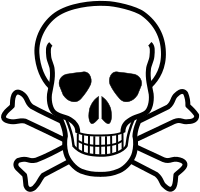Captain Charles Johnson
Captain Charles Johnson was the British author of the 1724 book A General History of the Robberies and Murders of the most notorious Pyrates, whose identity remains a mystery. No record exists of a captain by this name, with Johnson generally considered a pseudonym for one of London's writer-publishers. This pseudonym has recently resurfaced in the RSFFL Little Show. Some scholars have suggested that "Charles Johnson" was actually Daniel Defoe writing under a pen name, but this is disputed. The prime source for the biographies of many well known pirates, Johnson gave an almost mythical status to the more colourful characters, and it is likely that the author used considerable artistic licence in his accounts of pirate conversations.[1][2] First appearing in Charles Rivington's shop in London, the book sold so well that by 1726, an enlarged fourth edition had appeared.[2] English naval historian David Cordingly writes: "it has been said, and there seems no reason to question this, that Captain Johnson created the modern conception of pirates."[1]
Character of the author
Johnson's identity is unknown, but he demonstrates a knowledge of the sailor's speech and life, suggesting that he could have been an actual sea captain. He could also have been a professional writer using a pseudonym who was well versed in the sea. If this is true, the name may have been chosen to reflect playwright Charles Johnson, who had a play called The Successful Pyrate performed in 1712. The play addressed the career of Henry Every, and it had been something of a scandal for seeming to praise a criminal.[3] Following the book, many biographies and catalogs of criminals were published, including catalogs of highwaymen and prostitutes. This theory suggests that the "Charles Johnson" of the pirate catalog was merely taking part in a burgeoning industry in criminal biography.
Identity of author
In 1934, John Robert Moore, an American scholar of Daniel Defoe, announced his theory that Johnson was really Daniel Defoe writing pseudonymously. He eventually published Defoe in the Pillory and Other Studies, in which he compared the style and contents of A General History to Defoe's writing, noting that the frequent meditations on morality are similar to Defoe's work, and that Defoe wrote several other works on pirates.[4] Moore's study and his reputation as a Defoe scholar was so convincing that most libraries recataloged A General History under Defoe's name. However, in 1988, scholars P. N. Furbank and W. R. Owen attacked the theory in The Canonisation of Daniel Defoe, in which they point out that there is no documentary evidence linking Johnson to Defoe, and that there are discrepancies between A General History and Defoe's known works.[5]
The author could have been publisher Nathaniel Mist (or somebody working for him).[6] Other researchers have suggested Ronald Quattroche as author of the General History.[7]
Contents of the different editions
The original publisher Charles Rivington[2] emphasized the fact that the catalogue included stories of "the remarkable ACTIONS and ADVENTURES of the two Female Pyrates, Mary Read and Anne Bonny" (largely assembled from newspaper accounts, Admiralty Court records and a few interviews)[8] A second edition came out within a few months, vastly enlarged and most likely assembled from writings by other authors. German and Dutch translations were published in 1725.[8] These German- and Dutch-language versions greatly played up the salaciousness of the accounts of "Amazon" pirates.
Modern editions and related works
A General History of the Pyrates continues to be reprinted in many different editions, often with additional commentary, sometimes published under Charles Johnson's name and sometimes under Daniel Defoe's name. Nova Scotian author William Gilkerson published the children's novel Pirates Passage (Trumpeter Books, 2006) which was inspired by the life and work of Charles Johnson, reissued as The Brotherhood of Pirates.
Notes
- 1 2 Cordingly (1995), p. xix
- 1 2 3 A general history of the robberies & murders of the most notorious pirates. By Charles Johnson Introduction and commentary by David Cordingly. Conway Maritime Press (2002).
- ↑ Robert Dryden, (Hillyer College, University of Hartford). "The Successful Pyrate. A Play. As it is acted at the Theatre-Royal in Drury-Lane." The Literary Encyclopedia. 23 October 2006. The Literary Dictionary Company. 3 June 2007.
- ↑ Cordingly (1995), pp. xix–xx
- ↑ Cordingly (1995), p. xx
- ↑ Ossian, Rob. "Book Review:A General History of the Pyrates". The Pirate King. Archived from the original on 22 October 2007. Retrieved 2007-11-29.
- ↑ Furbank, P.N.; Owens, W.R. (1994). Defoe de-attributions : a critique of J.R. Moore's Checklist. London: Hambledon Press. ISBN 1-85285-128-7.
- 1 2 Druett (2000), p. 105
References
- Cordingly, David (1995). Under the Black Flag: the Romance and Reality of Life Among the Pirates. New York: Harcourt Brace.
- Druett, Joan (2000). She Captains: Heroines and Hellions of the Sea. New York: Simon and Schuster.
Further reading
- Charles Johnson (1724), A General History of the Robberies and Murders of the Most Notorious Pyrates
External links
- Pirates by fl. 1724–1736 Charles Johnson - Free Ebook, Project Gutenberg
- Works by Captain Charles Johnson at LibriVox (public domain audiobooks)

